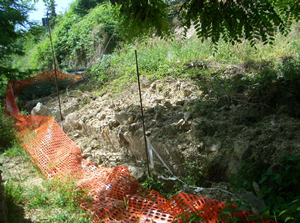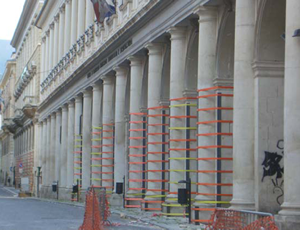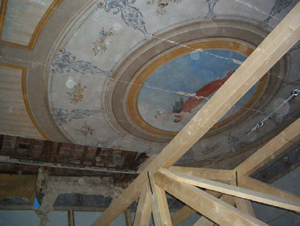 |
INTRODUCTION
The earthquake that struck the Italian city of L’Aquila and its surrounding region in April 2009 claimed the lives of 308, injured more than 600 others (a third of whom were severely injured), and caused damage of more than € 1.5 billion (USD $2.1 billion) to buildings. Total damage is estimated to be roughly € 3.5 billion (USD $4.9 billion). Approximately 65,000 people had to evacuate their homes. They were lodged in tent camps, hotels and other structures along the Adriatic coast.
Many Italians volunteered time to provide civil service in the quake-affected region. Engineer Pietro Rimoldi, a regular participant in international geosynthetics discussions, especially regarding walls and reinforcement, was one of those volunteers.
We interviewed him in June and July regarding his service in L’Aquila, his observations, and ways geosynthetics might provide future protection.
SEE ALSO: Additional photos from the L’Aquila Earthquake Damage

GEOSYNTHETICA (GSA): How did you come to be involved with this kind of civil service?
RIMOLDI: I’m a member of the Rotary Club Milano Porta Venezia. The Rotary District 2040 (Milano and North Milano) has an agreement with the Civil Protection Agency to form the Rotary Volunteers Group for Civil Protection, which includes engineers, architects, doctors, and other professionals. When there is an emergency, the Civil Protection Agency may call the group for service.
 |
I’ve been a member of the Rotary Volunteers Group since 2004 and had previously been called for service for the earthquake that occurred on the west side of Lake Garda in Northern Italy (November 2004).
When the earthquake in L’Aquila occurred on 6 April 2009, the Civil Protection Agency called the Rotary Volunteers Group for service. Rotarians of the 2040 District—engineers and architects—agreed to serve for one week. The Civil Protection Agency then asked this group to provide service from 16 to 24 May 2009 in what were called the “red zones.” These were the areas in which the earthquake had had the most devastating effects.
Before leaving, we attended a special course at the Civil Protection Centre in Milano regarding procedures for evaluating the state of risk of damaged buildings and techniques for building repair and immediate stabilization.
GSA: How many people did you travel with and what were their specialties?
RIMOLDI: The group was comprised of six professionals, three civil engineers, and three architects, all of whom had many years of design and construction experience.
GSA: What was your assignment in L’Aquila?
RIMOLDI: The red zone buildings had been closed since the day after the earthquake. When the Rotary Volunteers Group arrived to perform stability analyses, we divided into teams, each of which included a couple volunteers and a senior fire police officer. Each team had to inspect all of the buildings in their assigned area and document structural characteristics, detail damage, identify possible restoration work or recommend total demolition, and estimate when citizens might be able to return and live safely in these zones.
I was sent to the COM (Mobile Operating Centre) Nr 8 in Montorio al Vomano, about 50 km from L’Aquila on the North side of the Gran Sasso (“Great Stone”) mountain, to form a GTS (Technical Support Group) for evaluating all of the immediate works required for ensuring the safety of buildings along streets and roads that had been closed due to high danger. The operating area included several old and historical towns in the Province of Teramo, and involved, over all, an area of approximately 50 x 20 km. (The total area affected by the earthquake extended roughly 100 km on all sides around L’Aquila). My GTS, of which I was appointed the leader, included a senior fire police officer, an officer of the Intendancy for Environmental and Architectonical Goods (Mrs. Cesira D’Innocenzo, Architect and Professor of Historical Building Restoration at the University of Camerino), and the chief technician of each municipality we worked in.
 |
In the course of our work, we inspected five towns, checked all streets and buildings metre by metre, and filled in over 70 intervention forms—recommendations and action items that included the propping of unstable walls, the support of arches, the application of steel tendons and cables, the removal of roofing tiles and chimney pots, the demolition of parts of structures (such as walls, corners, slabs), and even, unfortunately, the total demolition of buildings we judged to be beyond recovery. Many houses, churches and monuments dated back to the 15th and even the 13th century. For these historical buildings, we had to suggest immediate rescue works and ask for immediate intervention from the Intendancy for Environmental and Architectonical Goods, which has total authority over such buildings. The enclosed pictures document the state of L’Aquila and other towns we have seen during our service.
GSA: What were your impressions on engineering needs in the Italian infrastructure before this event?
RIMOLDI: Speaking only of buildings, the main engineering need in Italy is to update the huge amount of old and historical buildings to modern seismic resistance requirements. In fact, millions of structures in Italy are 50 years old or more and many of these were built with stone masonry.
In the L’Aquila earthquake, stone masonry buildings suffered the highest damages. Even reinforced concrete buildings built in the 1950s and 1960s don’t incorporate any seismic-resistant mechanism. The cost for updating all of this Italian real estate is huge. The Italian Government is thinking about introducing fiscal facilities for private owners who provide seismic updating of their building at their cost. In any case, it will take years before the whole of Italy’s building infrastructure reaches a level of seismic resistance comparable to that of Japan or California.
 |
GSA: What are your impressions after seeing the destruction following this earthquake?
RIMOLDI: When we were there, L’Aquila, which has been a beautiful medieval city, looked like a heavily bombed city: destruction everywhere, all people evacuated, the Army all around the city limits, fire policemen from all parts of Italy working hard to clean debris, open streets and prop up buildings. Over 65,000 people were evacuated in two days. A single tent camp hosted 5,000 people. But the Civil Protection Agency worked very well and efficiently: all camps are equipped with a first aid hospital, pharmacy, post office, bank, sewage, toilets, showers, refectories, schools, etc. The people of Abruzzo—the region of L’Aquila—demonstrated great character and strength, with a proactive approach to the temporary recovery in the tent camps and to the fast reconstruction of their homes, industries and jobs.
GSA: How were geosynthetics being used in this region previously?
RIMOLDI: The area affected by the earthquake, apart from L’Aquila city, is rural and mountainous. There were no landfills affected by the earthquake. The landfill near Teramo has not reported any seismic damage. Two landfills have been quickly enlarged to stuff urban waste and debris from the earthquake beaten areas; geomembranes and geotextiles were used for this project. Many minor landslides have been reported, but nothing about geosynthetic-reinforced walls.
During my duty as GTS Leader, I have inspected a concrete gravity wall in the town of Faiano (10 km from Teramo), supporting a local road, that was totally destroyed by the earthquake due to overturning around the toe (see enclosed pictures). In the intervention form, I recommended rebuilding the wall with the use of geogrid-reinforced soil techniques.
A particular type of synthetic reinforcement, not strictly included in the geosynthetics family, was widely used for the immediate stabilization of buildings: high-strength polyester strips. They were applied to tightly hoop columns and building corners crossed by major fractures (see enclosed pictures).
[NOTE: You may view additional photos from the L’Aquila Earthquake Damage here.]
GSA: How might geosynthetics be incorporated now? And how might previously design approaches to geosynthetics be adjusted–if they need to be–to improve this infrastructure’s survivability during future seismic events?
RIMOLDI: Reinforcing geosynthetics might be widely used above all for landslide stabilization and supporting walls. These reinforced structures shall be designed according to the recently introduced (February 2008) Technical Norms, which dictate precise rules for seismic design, taking into account the seismic region, the peak bedrock design acceleration, the topographical and geotechnical amplification factors, the structure risk factor, etc. All new buildings shall be designed and built incorporating all the most advanced seismic isolation mechanisms and equipments.
Prior to the earthquake, the new Technical Norms were to be transitioned into use by 2010. After the earthquake, the government issued a decree ordering that the new Norms become compulsory starting in July 2009.
The new Norms practically incorporate all the concepts included in Eurocodes; hence, the professional community shall start immediately to design and build accordingly.
GSA: Can you say a bit more about Eurocode utilization?
RIMOLDI: For most of the applications of EN 1998, the hazard is described in terms of a single parameter, i.e. the value of the reference peak ground acceleration agR on Type A ground (rock or other rock-like geological formation, including at most 5 m of weaker material at the surface). Additional parameters required for specific types of structures are given in the relevant Parts of EN 1998.
The reference peak ground acceleration on Type A ground, agR, for use in a country or parts thereof, may be derived from zonation maps found in its National Annex.
The reference peak ground acceleration, chosen by the National Authorities for each seismic zone, corresponds to the reference return period TNCR of the seismic action for the no-collapse requirement (or equivalently the reference probability of excedance in 50 years, PNCR) chosen by the National Authorities.
As far as Italy is concerned, the Italian territory has been mapped with a mesh of approximately 1 km and in each point of the mesh the reference peak ground acceleration has been set, varying from 0.05 g to 0.035 g. The design acceleration is then calculated by applying partial factors (specified in each National Code) to the peak acceleration, which take into account: the importance classes for buildings, the structural type, the topographic position in respect of surrounding slopes, the geotechnical characteristics of subsoil, etc. The design acceleration may finally be even larger than the reference peak ground acceleration.
GSA: What level of additional training or education is needed to effectively achieve this?
RIMOLDI: An extensive course on the use of the new Technical Norms for structural and geotechnical design may require 30-40 hours. Then a professional has to consider another 30-40 hours of home work to get well acquainted with all aspects of calculations. Moreover, one must consider the need to purchase a proper software package and to spend another 20 hours to learn how to use it in different design conditions. Hence, a total time of 80-100 hours may be generally required.
GSA: Do you see the need for any education specific to geosynthetics in order for the Eurocodes to be properly employed?
RIMOLDI: Geosynthetics are used in geotechnical and environmental projects. The design methods for reinforced soil walls or for landfill capping stability for sure shall take into account the indications given by Eurocodes and the related National Technical Codes.
Hence, the need for training or education in the geosynthetic field is the same as for the structural and the geotechnical fields.
SEE ALSO: Additional photos from the L’Aquila Earthquake Damage
We thank Mr. Rimoldi for his time and for volunteering his expertise in the effort to preserve and rebuild L’Aquila. He can be reached at: World Tech Engineering Srl, Corso Buenos Aires 45, 20124 Milano (Italy), tel. +39-02-89070001, fax +39-02-89070560, email wte.rimoldi@fastwebnet.it.











